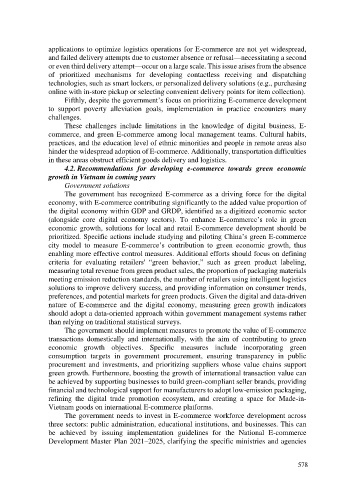Page 586 - Ebook HTKH 2024
P. 586
applications to optimize logistics operations for E-commerce are not yet widespread,
and failed delivery attempts due to customer absence or refusal—necessitating a second
or even third delivery attempt—occur on a large scale. This issue arises from the absence
of prioritized mechanisms for developing contactless receiving and dispatching
technologies, such as smart lockers, or personalized delivery solutions (e.g., purchasing
online with in-store pickup or selecting convenient delivery points for item collection).
Fifthly, despite the government’s focus on prioritizing E-commerce development
to support poverty alleviation goals, implementation in practice encounters many
challenges.
These challenges include limitations in the knowledge of digital business, E-
commerce, and green E-commerce among local management teams. Cultural habits,
practices, and the education level of ethnic minorities and people in remote areas also
hinder the widespread adoption of E-commerce. Additionally, transportation difficulties
in these areas obstruct efficient goods delivery and logistics.
4.2. Recommendations for developing e-commerce towards green economic
growth in Vietnam in coming years
Government solutions
The government has recognized E-commerce as a driving force for the digital
economy, with E-commerce contributing significantly to the added value proportion of
the digital economy within GDP and GRDP, identified as a digitized economic sector
(alongside core digital economy sectors). To enhance E-commerce’s role in green
economic growth, solutions for local and retail E-commerce development should be
prioritized. Specific actions include studying and piloting China’s green E-commerce
city model to measure E-commerce’s contribution to green economic growth, thus
enabling more effective control measures. Additional efforts should focus on defining
criteria for evaluating retailers' “green behavior,” such as green product labeling,
measuring total revenue from green product sales, the proportion of packaging materials
meeting emission reduction standards, the number of retailers using intelligent logistics
solutions to improve delivery success, and providing information on consumer trends,
preferences, and potential markets for green products. Given the digital and data-driven
nature of E-commerce and the digital economy, measuring green growth indicators
should adopt a data-oriented approach within government management systems rather
than relying on traditional statistical surveys.
The government should implement measures to promote the value of E-commerce
transactions domestically and internationally, with the aim of contributing to green
economic growth objectives. Specific measures include incorporating green
consumption targets in government procurement, ensuring transparency in public
procurement and investments, and prioritizing suppliers whose value chains support
green growth. Furthermore, boosting the growth of international transaction value can
be achieved by supporting businesses to build green-compliant seller brands, providing
financial and technological support for manufacturers to adopt low-emission packaging,
refining the digital trade promotion ecosystem, and creating a space for Made-in-
Vietnam goods on international E-commerce platforms.
The government needs to invest in E-commerce workforce development across
three sectors: public administration, educational institutions, and businesses. This can
be achieved by issuing implementation guidelines for the National E-commerce
Development Master Plan 2021–2025, clarifying the specific ministries and agencies
578

